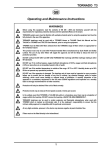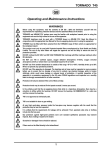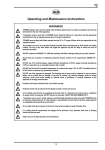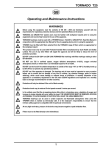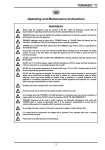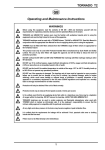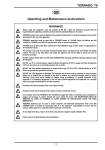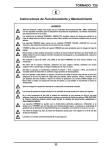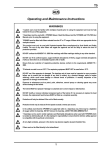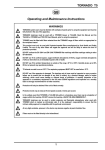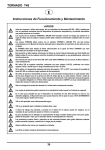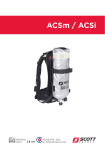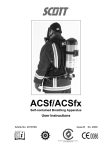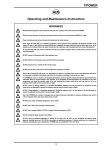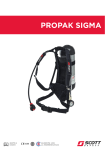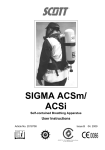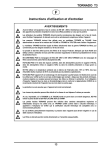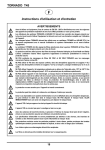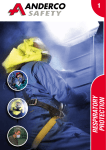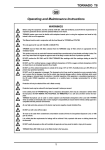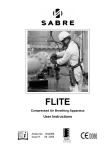Download T3 User Manual in Australian
Transcript
T3 Operating and Maintenance Instructions WARNINGS T/POWER system users must be familiar with workplace hazards prior to using the equipment and must be fully trained in the use of the apparatus. T head-tops must be used with a T/POWER blower. Read this Manual and the T/POWER and T/FILTER User Manuals, prior to using the equipment. T/POWER must be fitted with filters selected from the PF or TF range of filters which are appropriate for the workplace hazard. This product must only be used with Protector-branded filters manufactured by Scott Health and Safety Limited. The use of any other filters will negate the approval and will be likely to reduce the level of protection provided. DO NOT confuse the AS/NZS1716 : 2003 PF or TF filter markings with filter markings relating to any other standard. Ensure that your selection of respiratory protective devices conform to the requirements AS/NZS1715 : 2009. DO NOT use T3 in confined spaces, oxygen deficient atmospheres (<19.5%), oxygen enriched atmospheres (>23%) or where there is an immediate hazard to life or health. DO NOT use if the ambient temperature is outside of the range -10°C to +50°C. Humidity levels up to 95% RH do not present any operational problems. DO NOT use if the apparatus is damaged. The head-top and air hose must be inspected on every occasion before use to ensure that no damage of any kind is evident, (eg chemical damage, splits or broken stitching), which could cause leakage or reduced levels of protection. A monthly inspection of the apparatus is strongly recommended. Protection will only be obtained if the unit is fitted correctly. Protection levels may be reduced if wind speed exceeds 2 metres per second. In the unlikely event that the T/POWER air supply fails while in a hazardous area, there may be a depletion of oxygen within the head-top. DO NOT remove the head-top, LEAVE THE AREA IMMEDIATELY. T head-tops can be used in certain explosive and flammable atmospheres when used with T/POWER which is marked as intrinsically safe. It is the employer’s responsibility to ensure that the intrinsic safety approval is compatible with the particular environment. At very high work-rates, pressure in the device may become negative at peak inhalation flow. Filters must not be fitted directly to the helmet/hood. 1 T3 SPECIFICATION Description: Browguard with high heat faceseal Classification: AS/NZS1716 : 2003 PAPR-P2 Minimum Design Flow Rate: 140 L/min Required Minimum Protection Factor (RMPF) * when used with: Particulate Filters Gas/Vapour Filters Upto 50 x RMPF Upto 10 x RMPF Maximum Gas/Vapour Concentration present in the air: 1000 ppm (by volume) Operating Temperature Limits: -10°C to +50°C Material: Hood Visor Polyurethane-coated nylon Polycarbonate or Acetate options Weight: 770 Grams * According to AS/NZS1715 : 2009 • MARKINGS AND MEANINGS The T3 head-top conformance with follows: Marking markings are in AS/NZS1716, as Meaning SCOTT Manufacturer - Scott Health & Safety T3/AC Product name T3 with Acetate visor T3/PC Product name T3 with Polycarbonate visor 0086 Certifying body - (BSI) AS/NZS1716 Australian/New Zealand Standard PAPR-P2 Class designation Whilst all the materials which may come into contact with the wearer's skin are not known to be likely to cause skin irritation or any other adverse effect to health, they may cause allergic reactions in particularly susceptible individuals. 1. Examine the visor for damage or wear which may impair visibility or respiratory protection, e.g: deep scratches or abrasions. Check that there are no gaps between the visor and the visor holder. WARNING: Damaged visors that have come into contact with solvents, or have received a significant impact should be replaced. WEARING Note: Remove the protective transit film from the outside and inside surfaces of the visor before donning. 2. Check that the face-seal is fully attached to the visor holder and the elastic face-seal is not damaged or perished. CAUTION: • It is difficult to predict the life of visors in use. In every day use, and particularly when used outdoors, we would recommend that visors are discarded after two years service. In some extreme instances there may be deterioration over a shorter period of time. For indoor or occasional use we would anticipate a service life of about five years, provided that the visor is stored in cool dry conditions out of direct sunlight. 3. Use the hand-wheel at the back of the head-top to loosen the head harness and don the head-top. Use the pull tag to pull the face-seal under the chin. 4. Pull the head-top back so that it fits comfortably and securely under the chin and around the cheeks and the face-seal around the head, above the ears and below the ratchet. 5. Arrange the breathing hose so that it trails freely down the back and is not kinked, looped, or likely to snag. 2 T3 6. Tighten the hand-wheel until the head harness fits comfortably over the forehead. It may be necessary to adjust the crown strap to position the visor to the correct height for the face. STORAGE When not in use, the equipment should be stored in a clean, dry environment, away from direct heat sources between +10ºC and +30ºC, at a humidity of less than 65% RH. Note: The hand-wheel may require adjustment if the crown strap is adjusted. MAINTENANCE Carry out a thorough inspection of all component parts before and after each occasion of use, paying particular attention to the exhale valve flap. The valve flap must be replaced annually regardless of condition. Valve flaps in storage have a shelf-life of five years, after which time they should be discarded. 7. Please refer to the T/POWER User Manual for further information. AFTER USE WARNING: DO NOT remove head-top until safely clear of the hazardous area. Observe any site decontamination procedures. 1. Unscrew the air hose and (if required) use a synthetic sponge, moistened a warm soap and water solution to clean the head-top. TriGeneTM wipes may be used to disinfect the headtop. Exhalation valve flaps are marked with a code indicating the year of manufacture. The code ‘07' corresponds to 2007 and a dot is added each year thereafter, so ‘07.' would equate to 2008. CAUTION: • DO NOT use solvent or detergent cleaners as they may cause damage. • DO NOT allow water to enter the breathing hose. 2. Care should be taken not to scratch the visor. If the head-top or visor is damaged in any way, they should be replaced. 3 T3 RECORD INSPECTION AND MAINTENANCE DETAILS WARRANTY The products manufactured at our factories in Skelmersdale and Vaasa carry a warranty of 12 months (unless stated otherwise) for parts, labour and return to site. The warranty period runs from the date of purchase by the end user. Record test and maintenance details on the Inspection and Maintenance Record Sheet provided at the back of this Manual. Information recorded usually includes: • Name of employer responsible for the apparatus. • Make, model number or identification mark of the apparatus, together with a description of any distinguishing features, sufficient to enable clear identification. • Date of the inspection/ maintenance together with the name, signature or unique authentication mark of the examiner. • Condition of the apparatus, details of any defects found and any remedial action taken. These products are warranted to be free from defects in materials and workmanship at the time of delivery. SCOTT will be under no liability for any defect arising from wilful damage, negligence, abnormal working conditions, failure to follow the original manufacturer’s instructions, misuse or unauthorised alteration or repair. Evidence of purchase date will need to be provided for any claims arising during the warranty period. All warranty claims must be directed through SCOTT Customer Services and in accordance with our sales return procedure. NOTIFIED BODIES Inspec International Limited (0194) 56 Leslie Hough Way, Salford, Greater Manchester, M6 6AJ, England. BSI Product Services (0086) Kitemark House, Maylands Avenue, Hemel Hempstead, HP2 4SQ, England. SAI Global 286 Sussex Street, Sydney, NSW 2000, Australia. Certificate No. SMK1214 4 T3 SPARE PARTS Item No. 1 1 2 3 4 5 6 7 8 9 - Description Part No. Visor Visor Face-piece Shell Face-piece Hood Exhalation Valve Flap Exhalation Valve Cover Head Harness and Air Duct Sweatband Pivot Service Pack Breathing Hose Tear-off Visor Cover TriGene Polycarbonate Acetate (Pack of 5) (Pack of 2) (Pack of 5) (Pack of 20) (1 Set) (Pack of 3) (Pack of 10) (1 Litre) T3/VISOR/P/95 T3/VISOR/A/95 T3/SHELL T3/HOOD TOR/VALVE 2017146 T3/4/HEADGEAR HXSB40T T3/PIVOT T2/HOSE KIT96/VP/3 2008247 FITTING SPARES To Replace the Head Harness: To Replace the Exhale Valve: 1. Unscrew the air hose, free the hood from the air hose duct, remove the thumb nuts, washers, pivot plate and screws; and withdraw the head harness from the hood. 1. Pull the valve cover from the valve and pull the exhale valve flap from its housing. 2. Fit the replacement valve and check that the valve flap lies flat on the frame. Align the valve cover with the slots in the valve and snap it onto the valve. 2. Open the crown strap to free the elastic loops. 3. Pass the crown straps of the new head harness through the elastic loops of the hood, insert the head harness into the hood; and align the holes in the head harness, face-piece shell and hood. To Replace the Hose: Unscrew the old hose from the duct. Screw in the new hose ensuring that the fabric is trapped between the hose end and the duct. 4. Fit screws, thumb nuts, washers and pivot stop. 5. 5 Fit the hood over the hand-wheel. T3 6. Fit the air hose ensuring that the hood material is trapped between the head harness duct and the hose. To Replace the Face-piece Hood: 1. Unscrew the hose from the air duct and remove the thumb nuts, washers and pivot stop. To Replace the Sweatband: 2. Pull the old hood from the facepiece shell and hand-wheel; and release the elastic loops from the crown straps. 1. Pull the old sweatband to remove from the hooks on the head harness. 2. Fit the new sweatband onto the five hooks in the lower front of the headband, fold across that part of the headband nearest the head and clip on to the five hooks at the top of the headband. 3. Align the pull tab on the new hood with the bottom centre of the face-piece shell and attach evenly to the VelcroTM all the way around. 4. Ensure that the seal passes under the side washers and is located under the hand-wheel. Hook the elastic loops over the crown straps. To Replace the Visor: 1. Working from the rear of the faceshield, use the fingertips to lever the back edge of the visor away from the lugs. 2. Push the visor forward out of its holder. 5. Screw the hose back into the duct ensuring that the fabric is trapped between the hose and duct. 3. To fit a new visor, follow the reverse of the above procedure to snap the visor over the fixing lugs. 6. Tighten the thumb nuts to trap the face-seal under the washers. 4. Check that the visor presses firmly against the holder. 6






